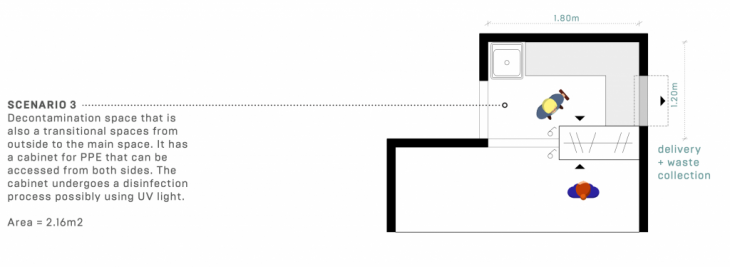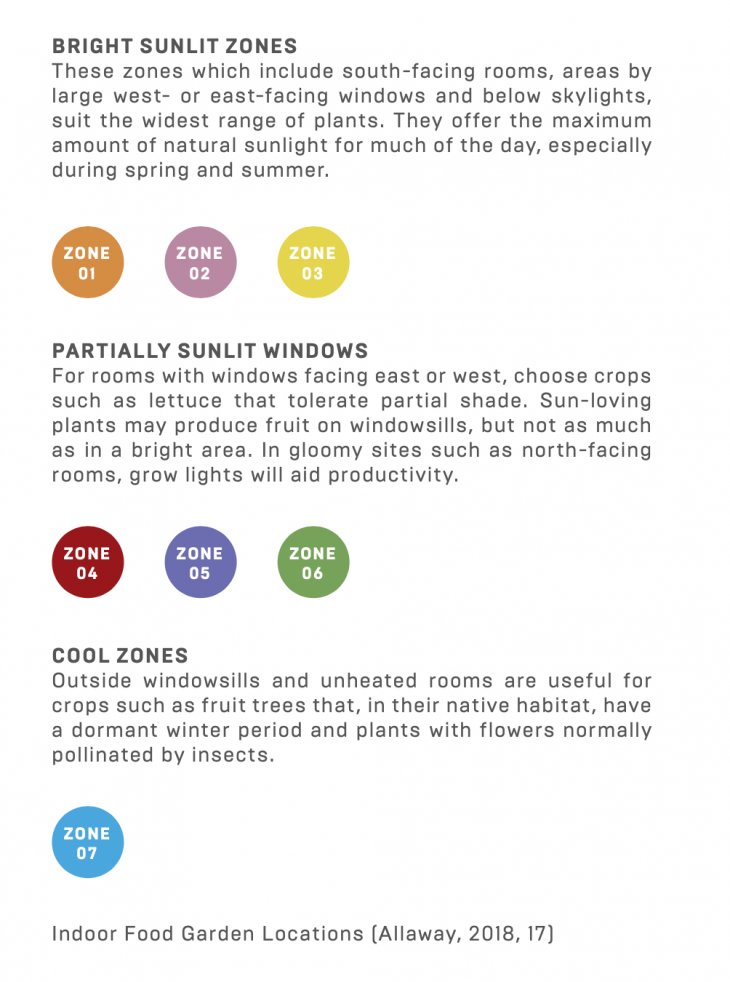_BRIDGING ENVIRONMENTS
Defined transition spaces provide segregation between areas with different classifications.
In the case of epidemics, these spaces can either operate as airlocks for high contamination levels or as zones to carry out decontamination processes at the least.
For an isolation/quarantine cabin, decontamination has to be carried out for objects and people entering the space. Objects can be in the form of food, medicine, or any other supplies and packaged items. The only people permitted to enter the cabin are doctors coming for check-ups.
“A ‘cascading’ airlock provides a transition space between areas of critical operations and less critical operations.” (Joseph, 2018)
These spaces can either be temporary or permanent. The state of permanence will inform the materials used for construction, the location of the space, and the exchanges that happen between them. Contagious diseases can be transmitted through several media including air and water. Systems should be designed in a matter to inhibit microorganisms from carrying the disease from being transferred between spaces. Airflow, water hygiene, sanitation, and waste management are key areas that need to be designed for and managed to inhibit the spread of diseases. The spatial configuration and materiality are dependant on these exchanges.



_Design Considerations for Decontamination Spaces
AIRFLOW
Ventilation and airflow are essential considerations for decontamination spaces. They determine the level of containment of the disease, preventing it from reaching other spaces. In cases where the disease is airborne, ventilation is a key aspect to consider and design for.
In cases of closed-off indoor spaces where mechanical ventilation is the primary source of air circulation, the following measures need to be applied:
- A fully closed space where not more than one opening is operated at a time
- Negative pressure; preventing contaminated air from reaching other spaces
- A good ventilation rate of a minimum of 8 fresh air exchanges/hour
- Extractors that operate independently from the rest of the building (Andersen, 2019)
For smaller buildings that do not include mechanical ventilation, sufficient cross ventilation is key to remove any air droplets carrying the disease. In the case of COVID-19, areas with high humidity are ideal for this passive application. (Murphy, 2020)
HUMAN AND INSTRUMENT FLOW
The flow of the users of the space and the instruments used for decontamination must be from the least clean to the cleanest. (HYGITECH Academy, 2017)
MINIMUM REQUIREMENTS FOR INSTRUMENTS AND FIXTURES
- Deep washbasin with non-touch taps
- Storage for PPE (Personal Protective Equipment)
- Storage for disinfectant
- Wastebin with a lid (UNICEF, 2020)





WASHING WITH SOAP AND WATER
The most basic method to disinfect objects for Coronavirus is washing hands and objects with soap and water. This is a primary step that can be followed by other processes of disinfection.
DISINFECTANT SPRAYS
- Salt-ions (15-20 seconds) (VietnamTimes, 2020)
- Electrolyzed water (30 seconds wet) + heat and ozone (30 seconds dry)
(Centers for Disease Control and Prevention, 2020)
UV LIGHT
It can be used for disinfection either as a handheld device or a fixture in a closed space. UV light disinfection can be used to disinfect:
- Air (better on still air)
- Water and wastewater treatment
- Equipment
- Surfaces(Hepacart, 2020)
ADVANTAGES OF UV LIGHT DISINFECTION
- Universal disinfectant; Kills a wide range of micro-organisms that can carry disease (ex. Bacteria, viruses, fungi, and mold)
- Does not use any chemicals
- Does not have any harmful by-products
SURFACE MATERIALITY AND POROSITY
Materials used for surfaces in decontamination rooms must meet certain requirements to ensure a high level of hygiene. The addressed surfaces are floors, walls, and countertops. These surfaces must be able to withstand strong disinfectants. Ideally, they would be non- porous surfaces that are smooth and easy to clean and without any cracks. For the case of COVID-19, it has been found that it survives a shorter duration on porous surfaces. However, this decontamination space should serve different upcoming diseases, making the choice for a hard and smooth surface which is easy to clean a more universal one.
According to current findings, the following are the durations of survival of COVID-19 on different materials:
- 72 hours on hard and shiny surfaces (glass, stainless steel, plastic)
- 24 hours on porous surfaces (fabric, paper, cardboard)
- 3 hours of airborne droplets (Mackay and Arden, 2020)

Decontamination chamber
_FOOD SECURITY
Today, more than 821 million people regularly go to bed hungry, of whom 100-plus million suffer from acute hunger, largely due to man-made conflicts, climate change, and economic downturns.
(World Food Programme, 2020)
Since the exponential expansion of COVID-19, fears of a potential food crisis have escalated. In a statement issued on March 19, 2020, the Committee on World Food Security (CFS) pointed the following: “As a result of these shifts and changes both in terms of addressing the disease and the broader economic fall-out, food availability is affected in both the short- and long-term. Food access is also compromised, in particular for those working in sectors that are likely to see job losses due to the recession as well for the poor who are likely to be made worse off. Nutrition is likely to be affected as people shift diets to more affordable as well as more shelf-stable and pre-packaged foods (which may be less nutritious) and as fresh fruits and vegetables become less available due to panic buying and disruptions in food systems. Stability is compromised as the markets themselves are highly unstable leading to a great degree of uncertainty.”
(FIAN International, 2020)


Kratky/Bay Window Garden
Why an indoor garden?
- Provides food security
- No packaging waste
- No spoilage
- No transportation costs
- No paying for any profit margins to the grower and the grocery store
- 90% less water
- 90% less expensive than store-bought produce.
Requirements – Kratky Method
1. Water, faucet, or rainwater.
Factors to be tested:
-pH
-Total dissolved solids (TDS) or conductivity -Chlorination.
2.Indoor LED Greenhouse.
Plants absorb energy from the same spectrum of light as humans see, but our sensitivity
to the colors is different from the plant’s sensitivity. Where our eyes are most sensitive to green light (550-nanometer wavelength), plants absorb blue light (450-nanometer wavelength) and red light (660-nanometer wavelength) more efficiently.
Research shows that the optimal ratio of light to get the highest plant yield to the energy consumed is roughly 65% Red, 15% Blue, and 20% Green.
High quality LED Grow light that will provide even lighting over a 1m by 0.50m area of the shelf for each shelf you plan to use. It is recommended to use a 33-inch Procyon Happy Leaf grow lights that have been optimized for vegetative and flowering plant growth.
3. Wide mouth quart size canning jars.
4. 3-inch diameter net pots to place into the canning jars to hold your plants. They can
be sanitized between crops and reused for a lifetime.
5. Hydroponic clay pellets. These are made of natural fired clay. They can be sanitized between crops and reused for a lifetime.
6.Nutrients
7.Sensor (18 hrs of light)
8. Seeds
(Victor Zaderej & BJ Miller, 2019)


OUTDOOR/ INDOOR GARDEN
WHO Facts
- Up to 2.7 million lives could be saved annually with sufficient fruit and vegetable consumption.
- Low fruit and vegetable intake are among the top 10 selected risk factors for global mortality.
- Worldwide, low intake of fruits and vegetables is estimated to cause about 19% of gastrointestinal cancer, about 31% of ischaemic heart disease, and 11% of stroke.
(World Health Organization, 2005)
What can be grown?
Fruits: Strawberries – Lemon – Negro Largo Figs
Outdoor pots: Apricots -Figs – Apple -Peach -Plums -Watermelon -Papayas
Vegetables: Lettuce -Carrots -Arugula – Kale – Scallions – Tomatoes – Ginger – Spinach – Chard – Herbs – Microgreens
“In 2 to 5 weeks, you will have micro-greens, lettuce, chard, herbs, and spinach ready to eat.”
Options like micro-greens could be very efficient for small spaces. They also need less light requirements and grow faster than the other leafy plants. They can be located anywhere in the Kratky arrangement or in any other arrangement option.
Micro-greens are highly intense in flavor and in nutrients. In fact, it was discovered in a recent study published by the Journal of agriculture and food chemistry that the concentration of nutrients inside microgreen leaves is highly superior from the concentration you can find in mature plant leaves. 25 different species of microgreens were analyzed in this research and it was proven that in some cases you can find from 4 up to 40 times more vitamins or carotenoids in the microgreen leaves.
These small vegetables are young shoots that are harvested typically 5 to 20 days after germination when they only measure a few centimeters high.
(American Chemical Society, 1953–present)

“How to Bridge Environments and Establish Food Security” is a research of IaaC, Institute for Advanced Architecture of Catalonia, developed at the Master in Advanced Ecological Buildings in 2019/2020 by:
Students: Dania Aburouss and Nathalie Botbol
Faculty: Vicente Guallart and Daniel Ibañez